Expanding internationally is a tried and tested growth tactic for many businesses. The internet has made it realistic for pretty much any company to sell products or services in overseas territories.
Yet, despite the low barriers to entry into new markets, there's one common mistake that's often made: failing to localize a website's content.
All too often, a website's content gets translated to the most commonly spoken language in a new territory (sometimes even that doesn't happen, and English is used as a default even in countries where that's not the main language.)
But translation on its own is rarely good enough.
That said, many companies are still struggling with the concept of localization, with commonly asked questions including "Should we translate the whole site?" "Should we hire native copywriters?" and "How do we measure the content’s success?"
It's incredibly important to go one step further than translation and localize your content for your new market's audience. In this guide, you'll learn exactly what content localization is, when you should be localizing, and how to approach localizing different types of content.
Specifically, we'll look at:
What is Content Localization? When Should You Localize Your Content? 6 Reasons to Localize Your Content Understanding The Different Types Of Content and The Localization Mistake That's Often Made How Can You Measure Localized Content Success?What is Content Localization?
Content localization is the process of taking content that you've produced for your primary market and adapting it for your new target market. It's not the same as translation, yet these are often mistakenly used interchangeably.
In some cases, content localization will involve translation. Let's say you're taking the content you've created for your audience in the U.S. (written in American English) and localizing this for your new target market of France. French is the first language of 88% of the population, so you would want to translate your content to French in this case.
However, localization is more than translation. It's the process of making your content culturally relevant and easy to understand in context.
To give an example, let's say you're taking the same content as above (written for the U.S. market in American English) but launching into the U.K.
Both these markets speak English as their first language, so it's understandable why there's a temptation to use the same content, word for word.
But the same words can mean different things in different countries, even when they speak the same language. To give a few scenarios:
What the U.S. calls chips, the U.K. calls crisps. Chips in the U.K. are what the U.S. calls fries.
 US = Chips | UK = Crisps
US = Chips | UK = Crisps  US = Fries | UK = Chips
US = Fries | UK = Chips Content localization is all about making sure your audience can understand your content in the right context.
In this example, a U.S. web page that talks about chips would need to change these mentions to crisps when localizing for a British audience. Otherwise, the content won't make complete sense. Or, it'll be more difficult to understand.
You need to be considering content localization to improve your user's experience on your website. Aim to make their experience as personalized and as easy and enjoyable as possible, and you'll find that it's easier to convert traffic into customers or clients.
It's also important to remember that 'content' means more than just written copy. Images, videos, currencies, and other elements should be considered when localizing your websites' experience, as well as things like payment gateways for ecommerce retailers (payment preferences change from country to country, so be sure to use those that your target market are the most comfortable using).
When Should You Localize Your Content?
One of the most commonly asked questions is when should you localize your content?
The simple answer is as soon as possible.
If you're planning to launch in new markets, localize that content from day one. Otherwise, there's a chance you'll be missing out on conversion opportunities due to your content not engaging the local audience properly.
By adapting content for that country and its local market, you'll set yourself up in a better position to drive success from your marketing efforts.
If you've already launched in other markets but have only translated, not localized, your content, you should do so as soon as possible while measuring the impact to justify expansion across other territories.
You can use the SEMrush Market Explorer Tool to discover insights about your performance in other markets, see the market share that you hold, and see the countries where your presence is growing the quickest in.
Use these insights to help make decisions around prioritizing localization.

6 Reasons to Localize Your Content
Once you understand what content localization is and why it's so important, it's not difficult to justify. Here are six reasons you need to localize your content:
Localized content experiences better engagement than non-localized content due to targeted relevance and the audience's ability to easily understand the context.
Users have come to expect local relevance. Businesses who localize content can expect to see higher conversion or inquiry rates and lower bounce rates. It's all about improving customer satisfaction.
Without localization, you could be missing out on a large portion of people who could become your next client or customer. It's important to remember that 75% of the world's population doesn't speak English at all. Localizing your content to new markets is a proven path to growth. Create a bespoke experience for major markets that make sense for you to target as a rapid route to driving new sales.
Sometimes, localization is needed to avoid risk to your business due to the different meanings of words from country to country. It's the reason why many car brands are known to localize the names of their models, with an example being Ford's Fiera that means 'fierce' in Spanish. Let's also not forget KFC's failure to localize their ‘Finger-lickin’ good’ slogan. In China, this means ‘Biting your fingers off.’
Gain a competitive advantage. Many businesses ignore the importance of localizing their content, and doing so is often a proven way to get ahead of what others in your space are doing.
Localization can help to reduce the effectiveness and cost-efficiency of your marketing, utilizing existing content and marketing assets and adapting these to drive success in new markets. Getting straight to the point, it costs less to localize existing content than create content from scratch.
Understanding The Different Types Of Content and The Localization Mistake That's Often Made
It's not uncommon for businesses and marketers to think of their website's content as a single entity without acknowledging that there are usually different types of content in place that serve entirely different purposes.
When it comes to localization, they go ahead and get their content translated without thinking deeper. Usually, this means applying the same workflow to all the types of content that are in place.
This shouldn't be the case.
We've already outlined the importance of localization rather than just translation, and as every piece of content communicates different things, the approach to localization should also be different.
A website will typically involve the following types of content:
Brand Content: All content that talks about the brand: Homepage, “About Us,” “Why Us,” “Mission,” and “Vision” sections or pages. Anything that talks about your brand.
Marketing Content: Typically, the content that sells to or educates your customers: product pages, landing pages, category pages, blog posts, and more.
Technical Content: All manuals, product descriptions, product documentation, FAQs, user guides, etc. This type of content should always be translated accurately to avoid any incorrect use of your products or services.
Legal Content: Your Terms of Use, Impressum, disclaimers, and other legal content should comply with the laws of a certain state or country.
Back-end/System Content: Content that includes so-called locale: locally-specific items like form entries, number formats, etc.
Contact Information: Your contact page should include relevant contact details for the users and serve your business's location data clearly.
So then, let's take a look at the recommended localization approach for each of these different types of content.
Brand Content
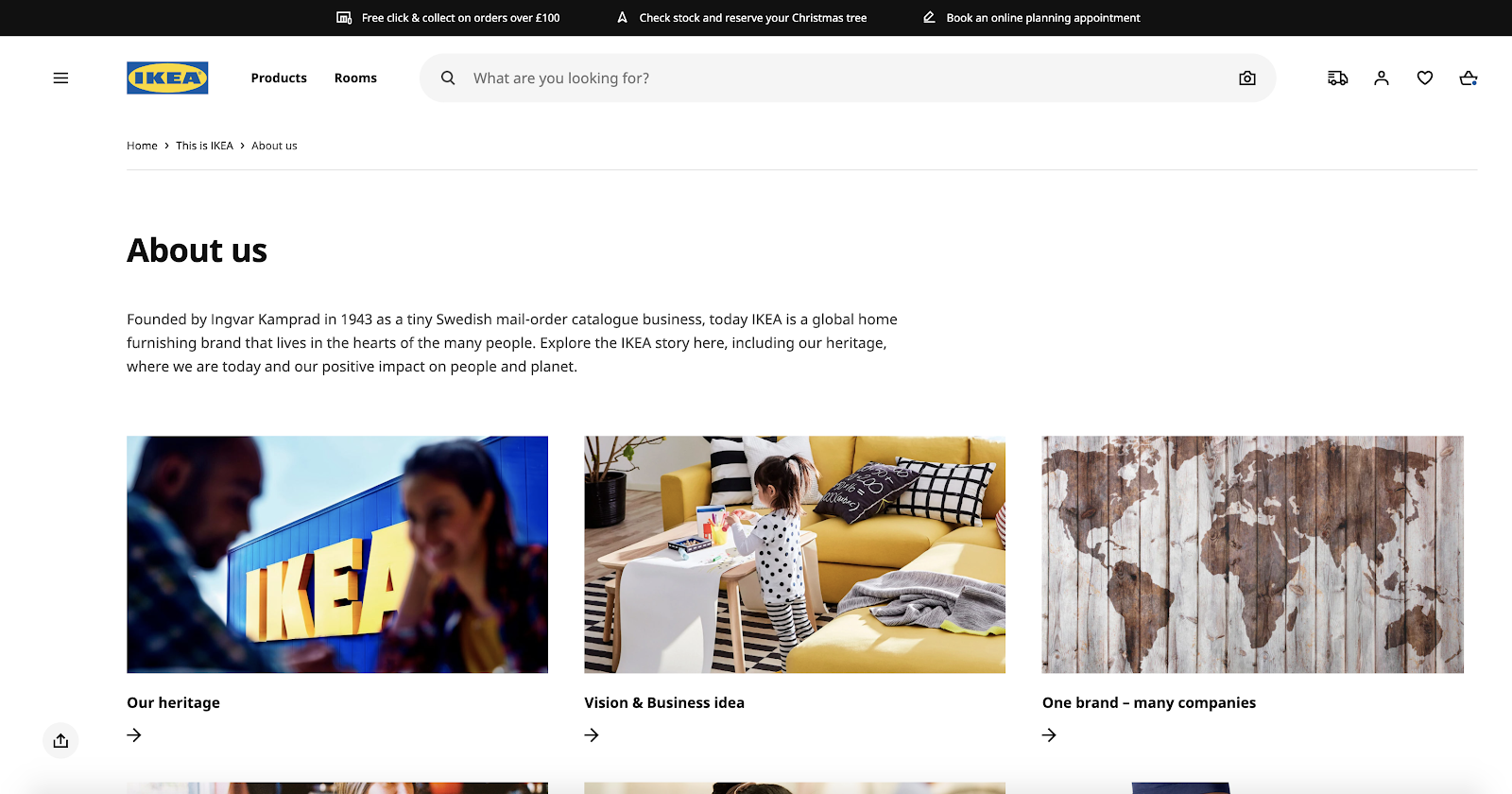
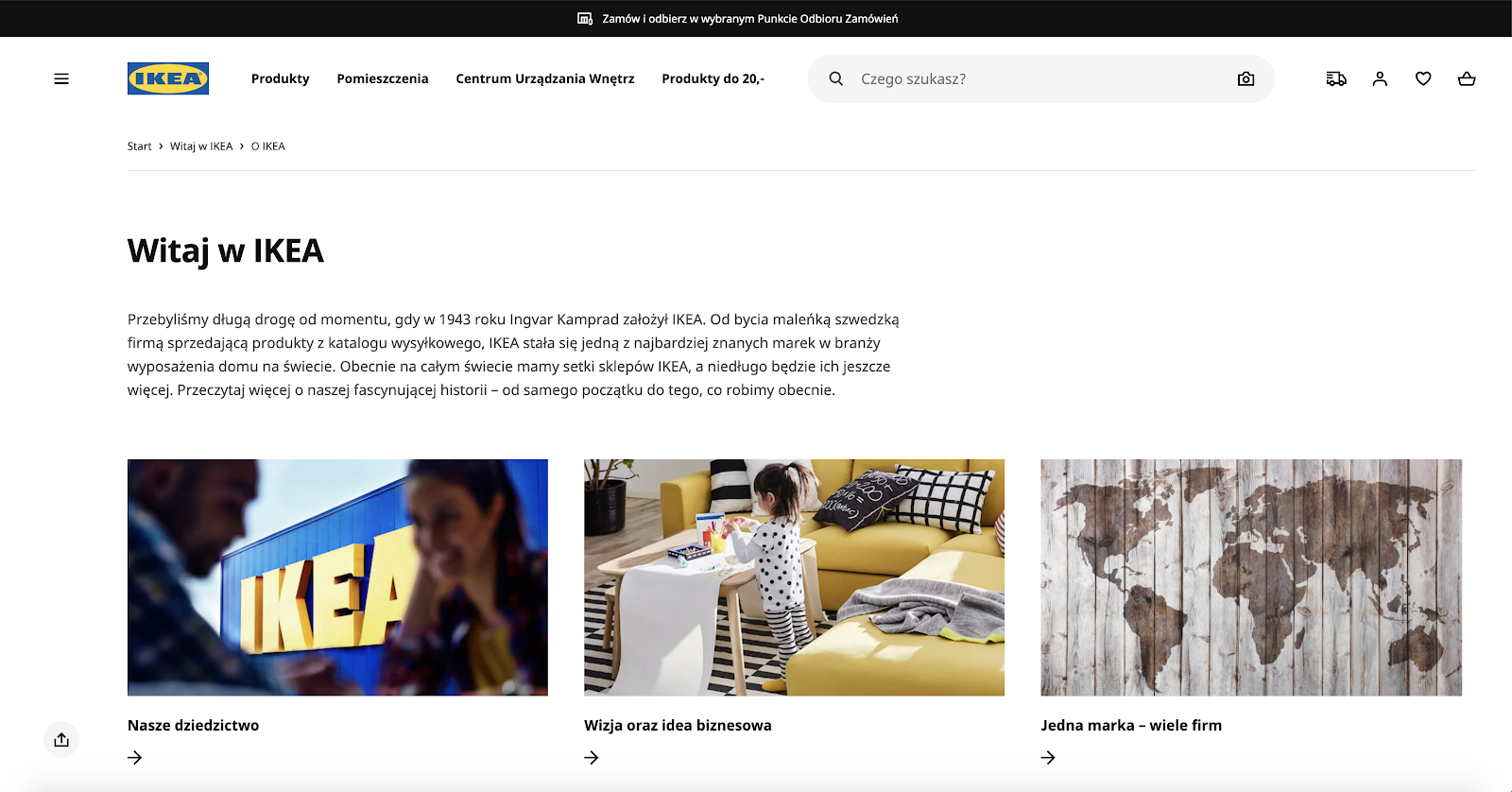
Here, we see a great example of simple and straightforward language focused on one key value (“a global home furnishings brand that lives in the hearts of the many people”), one key date (founded in 1843), and a link to relevant content for those who want to explore the brand further. Gender and ethnically-neutral images resonate with the message. This could not have been done without internationalizing the content—source: Ikea.com (English and Polish site).
What to do: Internationalize
Make sure your content speaks a neutral language without any regional connotations or metaphors.
Workflow: Translate > Review by local native > Gather suggestions > (Create Global Tone of Voice) > Finalize source content > Translate with the TOV > Proofread
Marketing Content
Let's look at the main model pages for the BMW i3 in the USA and the UK to help explain the route to take when localizing marketing content.
 BMW i3 US
BMW i3 US  BMW i3 UKHere is two model pages for the same car from the same manufacturer. However, they're drastically different in many ways, and this is as a result of localization.
BMW i3 UKHere is two model pages for the same car from the same manufacturer. However, they're drastically different in many ways, and this is as a result of localization. The content is tailored to the local audience, something that's essential when working with promotional or commercial content.
What to do: Localize
Make sure your marketing content speaks the language of your target audience and translate where necessary. Think about the target market's culture and considerations and focus on what matters the most to them.
Workflow: Write a brief > Localize & Translate > Proofread >
Technical Content
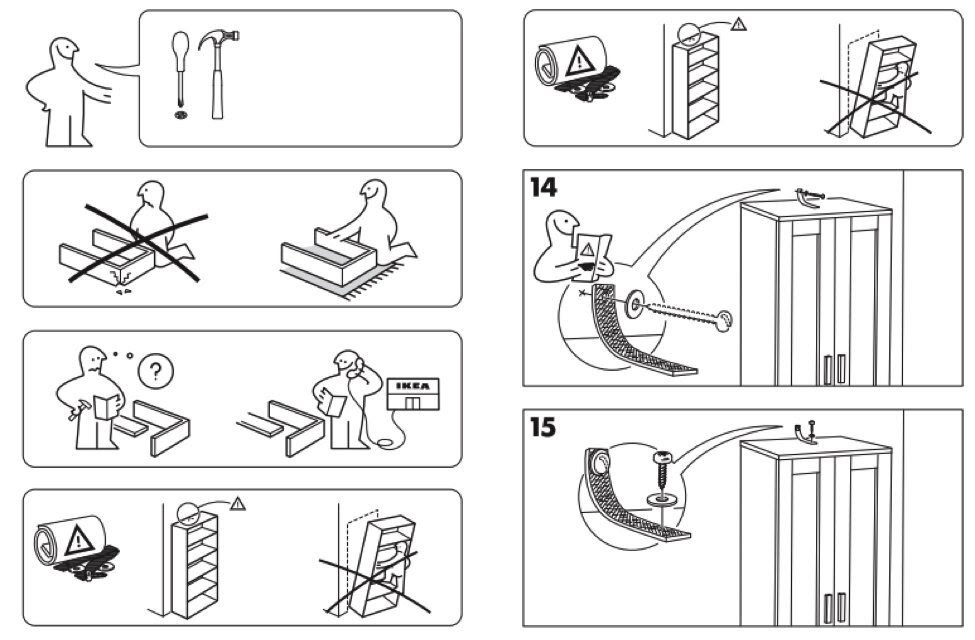
IKEA uses semiotics, i.e., internationally-comprehensible images, for their technical manuals. Not only do they make the entire manual easier to understand, but they also save millions of dollars on extensive technical glossaries and translation. Source: Ikea.com
What to do: Translate
Workflow: Prepare for translation > Create a glossary > Translate > Review > Proofread

Creating a glossary will help you keep the terminology consistent across all multilingual texts. This is also a great tool for maintaining keyword consistency across the whole website.
Source: https://support.google.com/translate/toolkit
Legal Content
All legal or other legislation-sensitive content such as compliance documents should be translated literally, focusing on locally-specific laws and regulations.
A field specialist (lawyer or attorney) review should be carried out as standard for this type of content, given the impact of getting it wrong.
Typically, global businesses will hire a translation agency that specializes in legal translation, which will, in turn, send the translated content to a local legal specialist for review.
The Importance Of Localizing Legal Content
There is one thing that greatly affects the performance of an international website - trust.
In some regions, e.g., Germany or Scandinavia, users are rather sensitive when it comes to correct legal content, and their buying decisions are made based upon trust.

Even if this legal content is perfectly by international laws, local users may not necessarily trust the website.
For that reason, be sure to localize legal content in line with local laws rather than relying on an international stance.
What to do: Translate and Localize
Workflow: Translate > Localize > Review by field specialist > Update > Final review
Back-end/System Content
System texts are specifically local in intent, and these often involve different locales: time and date formats and timezones, metric units, form items (address, ZIP), phone extensions, etc.
That’s why regular translation often results in barely relevant content that requires a lot of corrections.
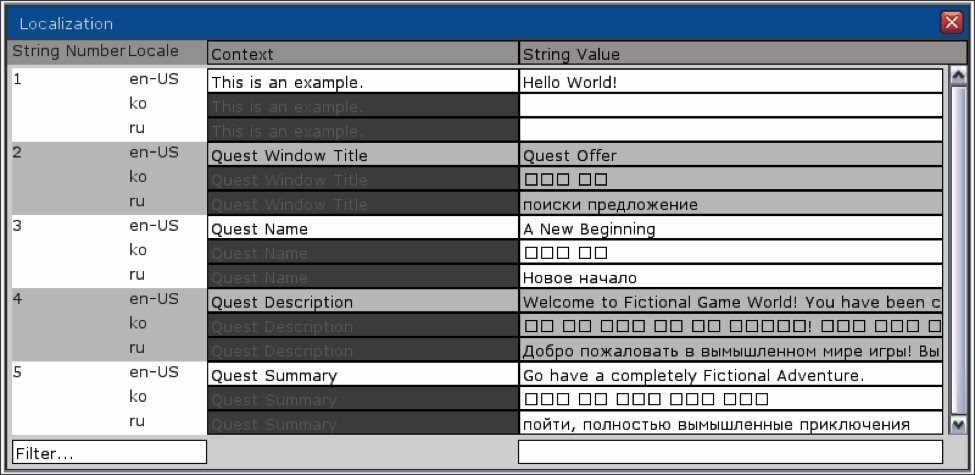
The above example shows strings in a localization tool. Image credit: http://hewiki.heroengine.com
What to do: Localize
You need someone who is familiar with localization and uses localization tools. Key strings should come with additional context.
Workflow: Create glossary > Select tools (below) > Export > Translate > Import > Test > Review > Update > Final Import
Local Content
Simply, make sure local content is created from scratch.
And to maximize your content's local SEO potential, there are several factors that you'll need to consider.
This:
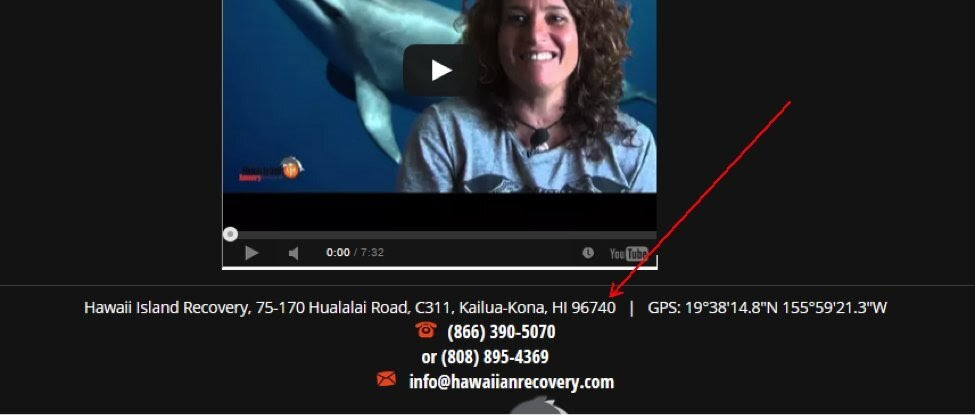
And this:

Becomes this:
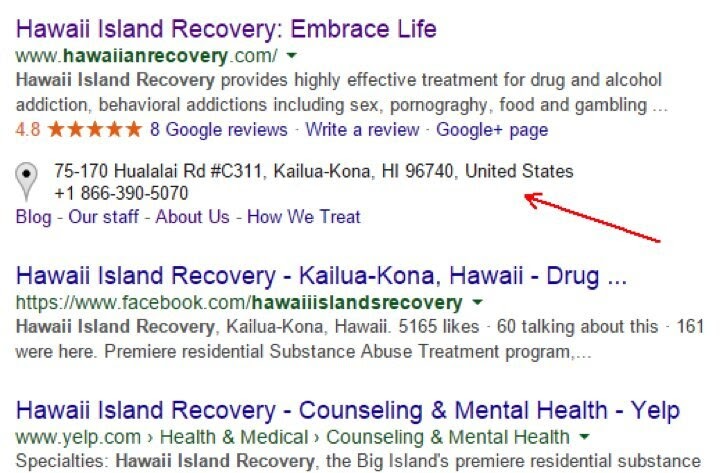
Use the checklist below to reference key content to pay attention to and localize:
Phone numbers with international codes
Local email addresses
Full address
ZIP or equivalent
GPS information
Hours of operation in local format (if applicable)
Schema.org local business mark-up
Embedded Google map
How Can You Measure Localized Content Success?
One of the most important things to do when localizing content is to measure its success.
After all, seeing results from your efforts is key to justifying the tactic, further investment, and showing the impact to your stakeholders.
One of the most effective ways of doing this is to use Google Sheets and the Google Analytics add-on, in which you can create your own report.
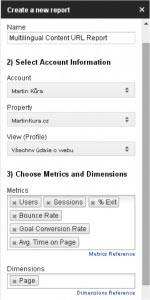
Here's how to do it:
Open a new Google Sheet
Click Add-ons, Get Add-ons
Select the Google Analytics add-on
Once installed, click Add-ons > Google Analytics > Create a new report
Set the values as in the image above
Select Add-ons again, click Run reports
The report will be created
Use Filters in the spreadsheet to filter the content you want to see/compare
You can now easily compare the core quality metrics of individual pages and even equivalent pages in different languages. In terms of the metrics, you'll want to measure success against:
Bounce rate
Conversions and conversion rate
Time on page
Exit %
Sessions
Unique users
If you're localizing content for the first time, pay close attention to these metrics and how they compare to your pre-localization benchmark as a measure of success.
All in all, it's important to consider content localization when you're building a website for different audiences. It's not just simply translating your website, though that is part of it, but preparing your site and its content for absorption by a wider audience that needs to understand exactly what you're trying to do. Follow our tips on content localization, and you'll be well on your way to success!
Innovative SEO services
SEO is a patience game; no secret there. We`ll work with you to develop a Search strategy focused on producing increased traffic rankings in as early as 3-months.
A proven Allinclusive. SEO services for measuring, executing, and optimizing for Search Engine success. We say what we do and do what we say.
Our company as Semrush Agency Partner has designed a search engine optimization service that is both ethical and result-driven. We use the latest tools, strategies, and trends to help you move up in the search engines for the right keywords to get noticed by the right audience.
Today, you can schedule a Discovery call with us about your company needs.
Source:




![How To Create a Strategic Dashboard in Excel Using Semrush Data [Excel Template Included]](https://new.allinclusive.agency/uploads/images/how-to-create-a-strategic-dashboard-in-excel-using-semrush-data-excel-template-included.svg)
